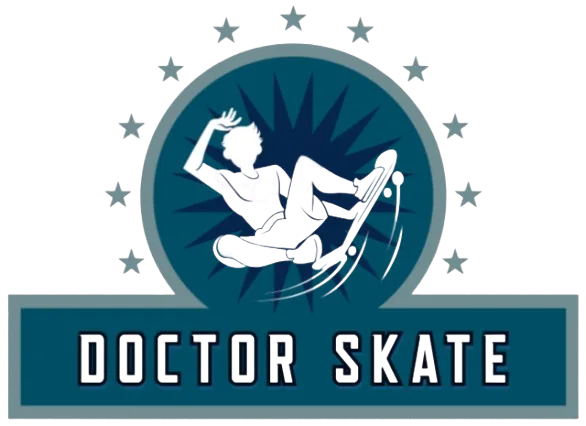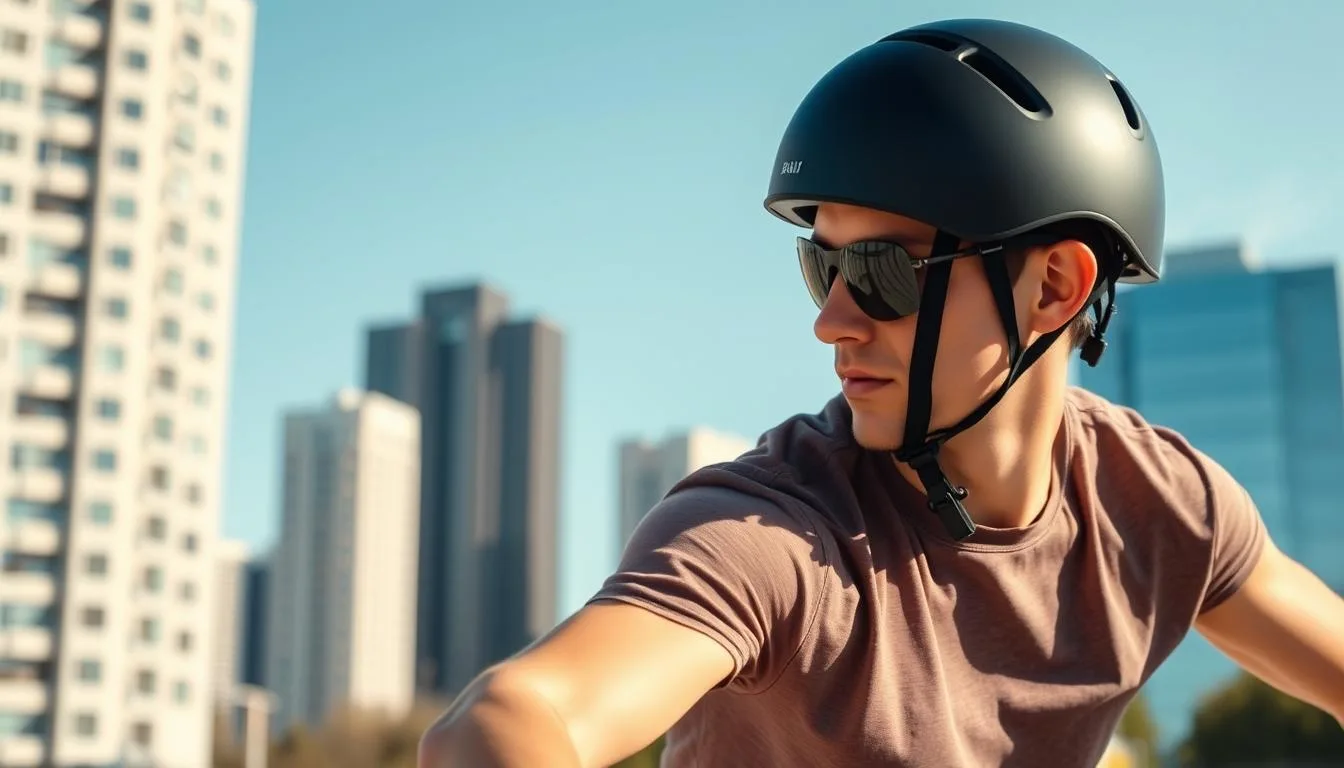Many ask if helmets are needed for skateboarding. Skateboard helmet necessity is a hot topic. Skateboarding is fun but has risks. About 20% of skateboarding injuries are head injuries. This shows the importance of wearing a helmet. Even Tony Hawk recommends helmets. He believes they are key to avoiding not just minor, but also major head injuries like concussions.
A good skate helmet costs between $30 to $130. This is a small price for safety. Helmets should meet specific standards like ASTM F1492 and 16 CFR Part 1203 for best protection. Brands like Triple 8, Pro-Tec, and Bell mix safety with style. This encourages skaters to wear helmets. By wearing a helmet, head injury risk drops by 85%. It shows how critical helmets are for safety.
Key Takeaways
- Head injuries make up around 20% of all skateboarding injuries.
- Skateboard helmet necessity is advocated by professional skaters such as Tony Hawk.
- Good quality helmets range from $30 to $130 and meet ASTM F1492 and 16 CFR Part 1203 standards for maximum protection.
- Wearing a helmet can reduce the risk of head injury by 85%.
- Popular skateboard helmet brands include Triple 8, Pro-Tec, and Bell.
Understanding the Risks of Skateboarding
Skateboarding is fun but comes with risks like falls and collisions. These can cause injuries from minor scratches to serious ones. Serious injuries include fractures and concussions. The CDC offers guidance on choosing the right helmet to reduce these risks. It’s important to wear protective gear, including helmets.
About 70,000 skateboarders end up in the emergency room each year. Almost half are kids under 15, mostly boys. They often suffer from wrist fractures, facial injuries, and concussions. A big issue is that young skateboarders often think they’re better than they are. This can lead to accidents.
Kids under 5 shouldn’t skateboard, says the American Academy of Pediatrics. Kids aged 6 to 10 need an adult watching them. Head injuries are common, especially in skaters under 10. Safety gear like helmets, pads, and closed-toe shoes is a must.
Experts say helmets can greatly lower the risk of head injuries. These include concussions, which can lead to serious brain diseases. Our brains can only handle so many concussions. Check the skateboarding safety standards for the best protection.
With skateboarding now an Olympic sport, there’s a big push for wearing helmets. This sets a good example for young skaters. Community skateboard parks are popping up. They’re supervised and encourage wearing the right gear. This helps make skateboarding safer.
Benefits of Wearing a Helmet
Wearing skateboarding helmets greatly reduces head injury risks. Studies show helmets lower head and brain injuries by 65-88%. This matters a lot since 88% of helmet users have fewer head injuries than those without.
Helmets protect well in different situations. They cut down risks by 69% in car crashes and 68% in skateboarding accidents. Helmet safety benefits also include less chance of concussions and C.T.E. This brain problem often strikes athletes with many head injuries. If you fall hard, a helmet might cut death risk by 37%.
Wearing a helmet also boosts a skater’s confidence. It helps you try bigger tricks and moves safely. This mental boost is a big reason to wear a skateboard helmet.
Also, helmets set a good example in the skate world. Promoting safety, especially to young riders, shows how important it is. Helmets meeting CPSC 1203 and ASTM F1492 standards cover the back of the head well. This is key because skaters often fall backward.
In short, skateboarding helmets offer many benefits, including safety and mental perks. By wearing one, you protect yourself and help the skate culture. You show everyone that safety comes first.
Legal Requirements for Skateboarding
In the United States, it’s important to know skateboarding laws to stay safe and follow local rules. Many states require helmets to reduce head injuries and their medical costs. These laws focus on young skaters and differ by place.
At the Olympic Games, athletes aren’t forced to wear helmets while skateboarding, but it’s advised. Yet, skaters under 18 must wear helmets in street events, or they’ll be out. In park events, every competitor has to wear a helmet.
Wearing a helmet can greatly lower the chance of serious head injuries or death from falling. Some pro skateboarders think helmets are heavy or unnecessary, but evidence shows they work. A bike helmet, for example, can cut the risk of head injury by 85%.
Skaters also might wear knee and elbow pads, along with wrist guards, especially in park skateboarding. Head injuries are the most common in skate accidents. Knowing helmet laws and skateboarding rules can keep you out of trouble and make skating safer.
Expert Opinions on Helmet Use
Tony Hawk is a big name when talking about skateboarding and helmets. He always says how vital helmets are. Being a pro, he knows how helmets can save lives.
Listening to what pros like Rodney Mullen say about helmets is super helpful. Mullen tells us that helmets do more than protect our heads. They give skaters the courage to try new things. Now, more and more skaters wear helmets, making it a common sight.
But it’s not just skateboarders who say helmets are important. Look at this data:
| Benefit | Impact of Helmet Use |
|---|---|
| Reduced Head Injuries | 48% |
| Reduced Serious Head Injuries | 60% |
| Reduced Traumatic Brain Injuries | 53% |
| Reduced Facial Injuries | 23% |
Stars like Tony Hawk, Bob Burnquist, and Rodney Mullen stress wearing helmets. Their support does two things. It helps avoid head injuries and encourages new skaters to put safety first.
Listening to these experts and wearing a helmet can make skating better and safer. Having pros speak up for helmet use shows us that being safe helps us grow in the sport.
Choosing the Right Helmet
Choosing the best skateboarding helmet involves important factors for your safety and comfort. First, focus on safety standards. Helmets meeting US Consumer Product Safety Commission (CPSC) or EN 1078 are best. They offer more protection, reducing head injury risk by 85% compared to non-certified helmets.
Getting the right fit is key to a good helmet. It should feel snug but not too tight. If a helmet is loose, it might fall off in an accident. But if it’s too tight, it could cause headaches. Companies like Outdoor Master have helmets for all head sizes, like the ProTec series. It includes helmets such as ProTec Skateboard Pads Low Pro Matte Grey Skate Helmet, for head sizes 22.44″ – 23.62″.
Don’t forget about comfort, especially ventilation. A helmet with good airflow keeps you cooler, which is vital in the summer. Helmets like the REKD Pathfinder and Powerslide Fitness Elite have extra vents. Some also come with MIPS technology to lessen the risk of brain injuries from rotational forces by up to 30%.
When choosing a skateboard helmet, think about how long it will last. Unlike bike helmets, the best skateboard helmets endure multiple impacts. For example, the Triple 8 Skateboard Pads Keegan Palmer Certified Sweatsaver Black Skate Helmet is a great choice. It’s suitable for frequent riders and costs $74.99.
It helps to know the features and prices of different helmets. Here’s a table comparing top helmets:
| Brand/Model | Head Size | Certification | Price |
|---|---|---|---|
| ProTec Low Pro Matte Grey | 22.44″ – 23.62″ | CPSC | $79.99 |
| ProTec Fullcut Matte Black | 23.6″ – 24.4″ | CPSC | $64.95 |
| Triple 8 Keegan Palmer Certified Sweatsaver | 22.5″ – 23.5″ | CPSC | $74.99 |
| REKD Pathfinder | Various Sizes | CPSC, EN 1078 | Varies |
| Powerslide Fitness Elite | Various Sizes | CPSC | Varies |
To pick the best helmet, think about safety, fit, comfort, and how long it lasts. This guide is to make choosing easier. It covers safety, fit, comfort, and helmet life. It’ll help you make a good choice, so you stay safe and enjoy skating.
Alternatives to Helmets
While helmets are highly recommended for skateboarding safety, there are other forms of head protection. These include padded headbands and caps made to lessen minor impacts. However, they don’t protect as well as a certified skateboard helmet does.
Padded headbands offer a lighter, more breathable choice for minor bump protection. They work best in safer areas with a lower risk of serious falls. Caps with padding provide some safety, keeping a casual look. Despite these, they don’t match a helmet’s full coverage.
Parents looking out for their kids’ safety might think about these alternative safety options for milder skateboarding. But for those who skate seriously or on tough terrains, choosing a helmet is wiser.
There are also smart caps with sensors that warn of possible crashes. These are exciting developments in safety technology. Yet, they don’t provide the strong protection that traditional helmets do.
When picking safety gear, think about how effective it is. While other options can be helpful in some cases, they shouldn’t replace a well-fitted, certified helmet in risky situations. For detailed info on skateboard safety and gear, check out Skateboard Safety.
Personal Stories: Helmet vs No Helmet
In the skateboarding world, Mike Vallely’s stories stand out. He has broken 17 bones in three decades of skateboarding. He talks about helmet safety through stories about his daughters, 23 and 15. This shows he’s been serious about helmet use for over 15 years.
Vallely’s stories show it’s hard to get teenagers to wear helmets. He sees this as a big challenge. Yet, he tells families to keep pushing for helmet use. He wants everyone to see helmets as normal.
Older skateboarders getting back into the sport are choosing to wear helmets. They’re influenced by data showing helmets make a huge difference. Around 88% of bike-related head injuries could be stopped by wearing a helmet. The chance of a head injury drops by 85% if a helmet is used during a crash.
Last year, Vallely won a gold medal at the X-Games and still put safety first. He proves that safety doesn’t limit success. More families skateboarding together choose helmets now. This shows a move towards a safer skateboarding world.
Yet, only about 30% of skateboarders wear helmets, as studies show. Not wearing a helmet leads to more ER visits for head injuries. Sometimes, these visits go up by 40% when fewer people wear helmets.
Head injuries from not using helmets cost the U.S. over $3 billion yearly in healthcare. This emphasizes the need for more helmet use. New helmet technologies aim at preventing concussions. This shows the growing benefits of wearing a helmet.
Stories from Mike Vallely highlight how vital helmets are in skateboarding. Helmets can prevent severe injuries and make skating safer. The message is clear: helmets save lives.
Making the Decision: To Wear or Not to Wear?
Choosing whether to wear a skateboard helmet is a big decision. It greatly affects your safety and how you enjoy skateboarding. Although half of kids don’t wear helmets for activities like biking or skateboarding, the stats reveal real dangers. Only 45% of kids 14 and under wear bike helmets. Yet biking leads to more emergency room visits for kids 5 to 14 than any other sport. This highlights the need for protective gear.
Wearing a helmet can lower the chance of serious head and brain injuries by 88%. Protection is vital since our brains can’t handle many concussions without lasting harm. C.T.E., seen in extreme athletes, shows the long-term risks. While culture and laws may sway your choice, the proof backs using helmets for skateboarding safety.
The Outdoor Master Oryx Skateboard Helmet meets top safety standards, offering strong protection during falls. It has 12 vents to keep you cool and a dial-fit system for a perfect fit. The helmet’s tough shell and foam liner lessen shock. It comes in sizes XS to XL, fitting all head sizes. So, choosing to wear a helmet becomes simpler when you think about staying safe. This way, you can skateboard without taking unnecessary risks.

I’m John Peterson, a passionate skater, blogger, and lifelong enthusiast. I’ve been skating for over 9 years and have gone on to write a blog dedicated to the sport of skating and its culture. Through my blog, I strive to share my knowledge and experience of the sport with all who are interested. From beginner tips, tricks, and equipment reviews to interviews and event coverage, I cover it all. So read my blog as I explore the wonderful world of skating!

